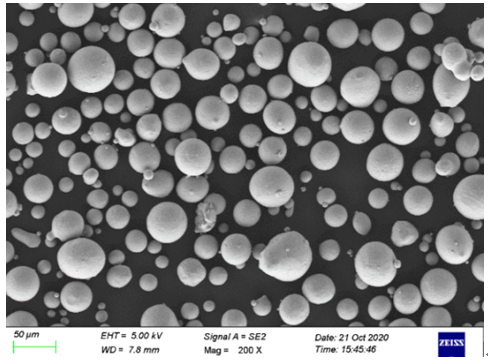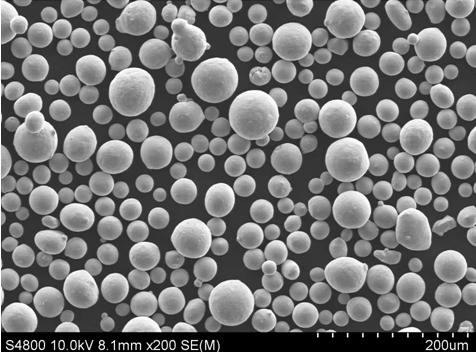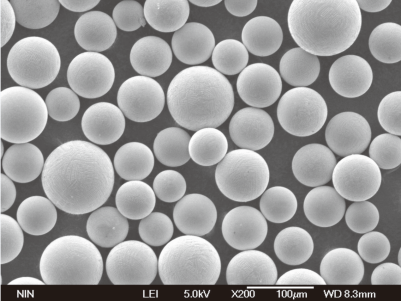مقدمة
مسحوق الحديد عالي النقاء مادة بالغة الأهمية تُستخدم في مختلف الصناعات، من المعادن إلى الإلكترونيات. ولكن ما الذي يجعلها مميزة للغاية؟ وكيف يختلف عن مسحوق الحديد العادي؟ في هذا الدليل، سنتعمق في هذا الدليل في عالم مسحوق الحديد عالي النقاء، ونستكشف تركيبته وخصائصه وتطبيقاته وغير ذلك الكثير. سواءً كنت محترفًا متمرسًا أو متعلمًا فضوليًا، فإن هذه المقالة مصممة للإجابة على جميع أسئلتك حول مسحوق الحديد عالي النقاء.
نظرة عامة على مسحوق الحديد عالي النقاء
مسحوق الحديد عالي النقاء هو مسحوق حديد بمستوى نقاء 99.9% أو أعلى. خواصه الفريدة تجعله مثاليًا للتطبيقات المتخصصة التي تتطلب قوة عالية أو موصلية ممتازة أو خواص مغناطيسية محددة. ينطوي إنتاج مسحوق الحديد عالي النقاء على عمليات متقدمة مثل الانحلال أو الاختزال، مما ينتج عنه مسحوق ناعم بحجم وشكل جسيمات متناسق.
الخصائص الرئيسية لمسحوق الحديد عالي النقاء
- النقاء: عادة ما تكون 99.9% أو أعلى
- حجم الجسيمات: يمكن أن تتراوح من بضعة ميكرومترات إلى عدة مئات من الميكرومترات
- الشكل: كروية أو غير منتظمة، حسب طريقة الإنتاج
- الخصائص المغناطيسية: مغنطة عالية التشبع
- التوصيل الكهربائي: ممتاز بسبب مستوى النقاء العالي

تكوين مسحوق الحديد عالي النقاء وخصائصه
| الممتلكات | الوصف |
|---|---|
| النقاء | 99.9% أو أعلى |
| حجم الجسيمات | من بضعة ميكرومترات إلى عدة مئات من الميكرومترات |
| الشكل | كروية أو غير منتظمة |
| التشبع المغناطيسي | عالية |
| التوصيل الكهربائي | ممتاز بسبب الحد الأدنى من الشوائب |
| الكثافة | تختلف باختلاف حجم الجسيمات وشكلها |
| مساحة السطح | أعلى في المساحيق الدقيقة |
| محتوى الأكسجين | منخفض، مما يضمن الحد الأدنى من الأكسدة |
أنواع ونماذج مسحوق الحديد عالي النقاء
هناك أنواع مختلفة من مسحوق الحديد عالي النقاء، كل منها مصمم خصيصًا لتطبيقات محددة. تكمن الاختلافات بين هذه الأنواع في حجم الجسيمات وشكلها وطرق إنتاجها. نناقش أدناه بعض النماذج الأكثر شيوعًا المتاحة في السوق:
1. مسحوق الحديد الذري
يتم إنتاج مسحوق الحديد المرذذذ من خلال عملية الانحلال، حيث يتم تشتيت الحديد المنصهر إلى قطرات دقيقة تتصلب إلى مسحوق. عادةً ما يكون لهذا النوع شكل كروي ويستخدم في التطبيقات التي تكون فيها قابلية التدفق وكثافة التعبئة مهمة.
- النقاء:: 99.9% أو أعلى
- التطبيقات: تعدين المساحيق، والمواد المغناطيسية، وقولبة حقن المعادن (MIM)
2. مسحوق الحديد المختزل
يتم إنتاج مسحوق الحديد المختزل عن طريق اختزال خام الحديد أو قشور المطاحن في جو هيدروجيني. وعادةً ما يكون له شكل غير منتظم ويستخدم في التطبيقات التي تكون فيها مساحة السطح حرجة، مثل التفاعلات الكيميائية أو كمحفز.
- النقاء:: 99.5% إلى 99.9%
- التطبيقات: التخليق الكيميائي، صناعة المستحضرات الصيدلانية، المواد المغناطيسية
3. مسحوق الحديد الإلكتروليتي
يتم إنتاج مسحوق الحديد الإلكتروليتي من خلال التحليل الكهربائي للحديد. وينتج عن هذه الطريقة نقاوة عالية جدًا وتوزيع متحكم في حجم الجسيمات. وغالبًا ما تُستخدم في التطبيقات التي تتطلب دقة ونقاءً عاليًا.
- النقاء:: 99.9% أو أعلى
- التطبيقات: الإلكترونيات وتصنيع البطاريات والمغناطيسات عالية الأداء
4. مسحوق الحديد الكربوني
يتم إنتاج مسحوق الحديد الكربوني عن طريق تحلل الحديد الخماسي الكربوني. وتنتج هذه الطريقة جسيمات كروية متناهية الصغر، وغالبًا ما تستخدم في التطبيقات التي تتطلب مغنطة عالية وأقل قدر من الشوائب.
- النقاء:: 99.9% أو أعلى
- التطبيقات: الإلكترونيات، المحاثات، التدريع الكهرومغناطيسي
5. مسحوق الحديد المضاف إليه ذرة الماء
على غرار مسحوق الحديد المرذذ، ولكن باستخدام الماء كوسيط للتشتيت، يتميز مسحوق الحديد المرذذ بالماء بأشكال غير منتظمة ويستخدم عند الحاجة إلى تحقيق التوازن بين التكلفة والأداء.
- النقاء:: 99.5% إلى 99.9%
- التطبيقات: تعدين المساحيق، وقطع غيار السيارات، وقولبة حقن المعادن (MIM)
6. مسحوق الحديد الذري الغازي
مسحوق الحديد المتذرر بالغاز، الذي يتم إنشاؤه باستخدام غازات خاملة لتفريق الحديد المنصهر، وعادةً ما يكون له شكل كروي أكثر اتساقًا ويستخدم في التطبيقات عالية الأداء.
- النقاء:: 99.9% أو أعلى
- التطبيقات: الفضاء، والطباعة ثلاثية الأبعاد، والمواد المغناطيسية
7. مسحوق الحديد فائق النعومة
يتميز مسحوق الحديد فائق النعومة بحجم جسيماته الصغير للغاية، وغالبًا ما يكون في نطاق النانومتر. ويستخدم في التطبيقات المتقدمة مثل الطلاءات والأحبار وتكنولوجيا النانو.
- النقاء:: 99.9% أو أعلى
- التطبيقات: الطلاءات، وتكنولوجيا النانو، والأحبار الموصلة
8. مسحوق الحديد عالي الكثافة
صُمم مسحوق الحديد عالي الكثافة للتطبيقات التي تتطلب أقصى كثافة تعبئة ويستخدم عادةً في المعادن عالية الأداء.
- النقاء:: 99.7% إلى 99.9%
- التطبيقات: صناعة الطيران، والسيارات، والآلات الثقيلة
9. مسحوق الحديد المغناطيسي
تتم معالجة مسحوق الحديد المغناطيسي خصيصًا لتعزيز خواصه المغناطيسية ويستخدم في تطبيقات مثل المحاثات والمحولات والدروع المغناطيسية.
- النقاء:: 99.9% أو أعلى
- التطبيقات: محولات، محاثات، محاثات، تدريع مغناطيسي
10. مسحوق الحديد المشكل بالرش
يتم إنشاء مسحوق الحديد المشكل بالرذاذ باستخدام عملية التصلب السريع، مما ينتج عنه بنية مجهرية فريدة من نوعها توفر خواص ميكانيكية محسنة.
- النقاء:: 99.8% إلى 99.9%
- التطبيقات: الأدوات، والأجزاء الهيكلية، والسبائك عالية الأداء
تطبيقات مسحوق الحديد عالي النقاء
يُستخدم مسحوق الحديد عالي النقاء في مجموعة واسعة من الصناعات نظرًا لخصائصه الاستثنائية. وتمتد تطبيقاته من علم المعادن التقليدي إلى الإلكترونيات المتطورة وتكنولوجيا النانو.
الجدول: تطبيقات مسحوق الحديد عالي النقاء
| مجال التطبيق | الوصف |
|---|---|
| تعدين المساحيق | تُستخدم لصنع أجزاء عالية القوة والدقة من خلال التلبيد وعمليات أخرى. |
| الإلكترونيات | ضروري في تصنيع المكونات مثل المحاثات والمكثفات والمحولات. |
| المواد المغناطيسية | تُستخدم لإنتاج مغناطيسات عالية الأداء لمختلف التطبيقات، بما في ذلك المحركات والمستشعرات. |
| التخليق الكيميائي | يعمل كمحفز في التفاعلات الكيميائية ويستخدم في إنتاج المواد الاصطناعية. |
| المستحضرات الصيدلانية | يستخدم في تصنيع بعض التركيبات الدوائية نظراً لنقائه العالي. |
| تكنولوجيا النانو | تستخدم في المواد والطلاءات المتقدمة، وغالبًا ما تكون على مستوى النانو. |
| تصنيع البطاريات | تستخدم في إنتاج البطاريات عالية الأداء، خاصة في مواد الكاثود والأنود. |
| التصنيع الإضافي | ضروري للطباعة ثلاثية الأبعاد وتقنيات التصنيع المضافة الأخرى، مما يوفر مساحيق دقيقة وموحدة. |
| التدريع الكهرومغناطيسي | تُستخدم في صناعة المواد التي تحمي الأجهزة الإلكترونية من التداخل الكهرومغناطيسي. |
| سبائك عالية الأداء | تُضاف إلى السبائك لتحسين خواصها الميكانيكية، خاصةً في تطبيقات الطيران والسيارات. |






المواصفات والأحجام والدرجات والمعايير
عند اختيار مسحوق الحديد عالي النقاء، من الضروري فهم المواصفات والأحجام والدرجات والمعايير المطبقة. يمكن أن تختلف هذه المعلمات اعتمادًا على التطبيق المقصود، ومعرفة الاختيار الصحيح يمكن أن يؤثر بشكل كبير على الأداء.
الجدول: مواصفات مسحوق الحديد عالي النقاء
| المواصفات | الوصف |
|---|---|
| مستويات النقاء | 99.5% إلى 99.9% أو أعلى |
| نطاق حجم الجسيمات | من النانومتر (نانومتر) إلى عدة مئات من الميكرومتر (ميكرومتر) |
| معايير التقدير | ASTM، ISO، JIS، حسب الصناعة |
| الأشكال المتوفرة | كروية، غير منتظمة، غير منتظمة، قشور |
| طريقة الإنتاج | الانحلال، الاختزال، الاختزال، التحليل الكهربائي، الكربونيل |
| نطاق الكثافة | يعتمد ذلك على حجم الجسيمات وشكلها؛ عادةً 2.5-7.8 جم/سم مكعب |
| الخصائص المغناطيسية | مغنطة تشبّع عالية، إكراه منخفضة |
| التوصيلية | توصيلية كهربائية عالية بسبب الحد الأدنى من الشوائب |
الجدول: درجات مسحوق الحديد عالي النقاء
| الصف | مستوى النقاء | التطبيقات |
|---|---|---|
| الدرجة أ | 99.9% أو أعلى | الإلكترونيات والأجهزة الطبية والمغناطيسات عالية الأداء |
| الدرجة ب | من 99.7% إلى 99.9% | تعدين المساحيق، والتخليق الكيميائي |
| الدرجة C | من 99.5% إلى 99.7% | التصنيع المضاف، مكونات السيارات |
| الصف دال | من 99.0% إلى 99.5% | المعادن العامة، والأدوات، والأجزاء الهيكلية |
تفاصيل الموردين والتسعير مسحوق الحديد عالي النقاء
يمكن أن يختلف توافر مسحوق الحديد عالي النقاء وتكلفته اختلافًا كبيرًا اعتمادًا على المورد والمنطقة ومتطلبات المنتج المحددة. وفيما يلي دليل لبعض الشركات الرائدة في
الموردين وتفاصيل أسعارهم.
الجدول: الموردون وأسعار مسحوق الحديد عالي النقاء
| المورد | الموقع | مجموعة المنتجات | نطاق السعر (لكل كيلوغرام) |
|---|---|---|---|
| هوغاناس إيه بي | السويد | المساحيق الإلكتروليتية المصغرة والمختزلة والمذرة | $50 – $200 |
| شركة JFE للصلب | اليابان | مسحوق الحديد عالي النقاء للإلكترونيات والمعادن | $80 – $250 |
| مساحيق ريو تينتو للمعادن | كندا | المساحيق المتذررة بالغاز والماء | $60 – $180 |
| BASF | ألمانيا | مسحوق الحديد الكربوني، المساحيق فائقة النعومة | $100 – $300 |
| تعدين المساحيق GKN | الولايات المتحدة الأمريكية | مساحيق الحديد المغناطيسية عالية الكثافة والمغناطيسية | $70 – $220 |
| ميتسوي للتعدين والصهر | اليابان | مساحيق مشكلة بالرذاذ، فائقة النقاء | $90 – $280 |
| مجموعة CNPC للمساحيق | الصين | المساحيق الإلكتروليتية المخففة والمذرة والمحللة كهربائيًا | $40 – $150 |
| كوبي ستيل | اليابان | الدرجات المتخصصة للتطبيقات المتقدمة | $110 – $320 |
| شركة ساندفيك لتكنولوجيا المواد | السويد | مساحيق الحديد عالية الأداء للفضاء والسيارات | $120 – $350 |
| العناصر الأمريكية | الولايات المتحدة الأمريكية | الجسيمات النانوية، المساحيق فائقة النعومة | $200 – $500 |
مزايا مسحوق الحديد عالي النقاء وحدوده
مثل أي مادة، يأتي مسحوق الحديد عالي النقاء مع مجموعة من المزايا والقيود الخاصة به. ويمكن أن يساعد فهمها في اختيار النوع المناسب للاستخدام الخاص بك.
الجدول: مزايا وقيود مسحوق الحديد عالي النقاء
| مزايا | محددات |
|---|---|
| قوة عالية | مثالية للتطبيقات التي تتطلب خصائص ميكانيكية قوية |
| خصائص مغناطيسية ممتازة | مثالي للمواد المغناطيسية والدرع الكهرومغناطيسي |
| عالية النقاء | يقلل من الشوائب، مما يعزز التوصيل والأداء |
| تطبيقات متعددة الاستخدامات | يمكن استخدامها في مجموعة واسعة من الصناعات من الإلكترونيات إلى المستحضرات الصيدلانية |
| التخصيص | متوفر بدرجات وأحجام وأشكال مختلفة لتناسب الاحتياجات الخاصة |
| التكلفة | يمكن أن تكون مستويات النقاء العالية باهظة الثمن |
| تعقيد الإنتاج | يتطلب أساليب إنتاج متقدمة، مما قد يحد من التوافر |
| الموردون المحدودون | ليست متاحة على نطاق واسع مثل مساحيق الحديد منخفضة الدرجة |
| حساسية الأكسدة | يمكن أن يكون الحديد عالي النقاء أكثر عرضة للأكسدة، مما يتطلب تخزينًا دقيقًا |
مقارنة مسحوق الحديد عالي النقاء بمساحيق المعادن الأخرى
كيف يمكن مقارنة مسحوق الحديد عالي النقاء بالأنواع الأخرى من مساحيق المعادن؟ دعنا نقارنه ببعض البدائل شائعة الاستخدام:
الجدول: مقارنة بين مسحوق الحديد عالي النقاء ومساحيق المعادن الأخرى
| المسحوق المعدني | مستوى النقاء | التطبيقات | مزايا | محددات |
|---|---|---|---|---|
| مسحوق الحديد عالي النقاء | 99.5% إلى 99.9% أو أعلى | الإلكترونيات، علم المعادن، التخليق الكيميائي | قوة عالية، وخصائص مغناطيسية ممتازة، وموصلية عالية | أعلى تكلفة، حساس للأكسدة |
| مسحوق الألومنيوم | من 99.0% إلى 99.8% | السبائك الخفيفة الوزن والألعاب النارية والطلاءات | خفيفة الوزن، وموصلية جيدة، ومقاومة للتآكل | قوة أقل، وخصائص مغناطيسية أقل |
| مسحوق النحاس | 99.9% أو أعلى | الأحبار الموصلة والإلكترونيات واللحام النحاسي | موصلية ممتازة، وخصائص حرارية جيدة | أعلى تكلفة، عرضة للأكسدة |
| مسحوق النيكل | من 99.0% إلى 99.9% | سبائك وبطاريات عالية الأداء | مقاومة للتآكل، وخصائص مغناطيسية جيدة | باهظة الثمن ومحدودية التوفر |
| مسحوق الفولاذ المقاوم للصدأ | من 95% إلى 99.5% | الأدوات، الطباعة ثلاثية الأبعاد، الأجزاء الهيكلية | مقاومة التآكل، قوة عالية | أثقل وأقل توصيلًا من المعادن النقية |
| مسحوق التيتانيوم | من 99.5% إلى 99.9% | الفضاء، والغرسات الطبية، والتصنيع الإضافي | نسبة قوة إلى وزن عالية، متوافقة حيوياً | مكلفة للغاية وصعبة المعالجة |
| مسحوق الكوبالت | من 99.0% إلى 99.9% | السبائك الفائقة والبطاريات والمواد المغناطيسية | مقاومة درجات الحرارة العالية، وخصائص مغناطيسية جيدة | باهظة الثمن ومحدودية التوفر |
| مسحوق الفضة | 99.9% أو أعلى | الإلكترونيات، والأجهزة الطبية، والأحبار الموصلة | أفضل توصيل كهربائي وخصائص مضادة للميكروبات | باهظة الثمن للغاية، وعرضة للتشويه |
| مسحوق الزنك | من 99.0% إلى 99.5% | الجلفنة والبطاريات والمستحضرات الصيدلانية | مقاومة جيدة للتآكل، غير مكلفة | قوة أقل، موصلية أقل |
| مسحوق المغنيسيوم | من 99.0% إلى 99.5% | السبائك الخفيفة الوزن والألعاب النارية والبطاريات | خفيفة الوزن للغاية وقابلية جيدة للتشغيل الآلي | شديد التفاعلية وقابل للاشتعال |
كيفية اختيار المناسب مسحوق الحديد عالي النقاء للتطبيق الخاص بك
قد يكون اختيار مسحوق الحديد عالي النقاء المناسب لاستخدامك قرارًا معقدًا. فيما يلي بعض العوامل الرئيسية التي يجب مراعاتها:
1. مستوى النقاء
يعتمد مستوى النقاء المطلوب على التطبيق الخاص بك. على سبيل المثال، في مجال الإلكترونيات والمستحضرات الصيدلانية، حيث يمكن أن تؤثر الشوائب بشكل كبير على الأداء، ستحتاج إلى مسحوق حديد بدرجة نقاء 99.9% أو أعلى. من ناحية أخرى، بالنسبة للمعادن العامة، قد يكفي مستوى نقاء أقل قليلًا.
2. حجم الجسيمات وشكلها
يمكن أن يؤثر حجم الجسيمات وشكلها على قابلية تدفق المسحوق وكثافة التعبئة ومساحة السطح. تُفضل المساحيق الكروية بشكل عام في التطبيقات التي تتطلب قابلية تدفق جيدة، مثل قولبة حقن المعادن، في حين أن الجسيمات غير المنتظمة قد تكون أفضل للتخليق الكيميائي بسبب مساحة سطحها الأعلى.
3. الخواص المغناطيسية
إذا كان تطبيقك يتضمن مواد مغناطيسية، ركز على مساحيق الحديد ذات التشبع المغناطيسي العالي والإكراه المنخفض. وغالبًا ما تكون مساحيق الحديد المغناطيسية ومساحيق الحديد الكربوني هي أفضل الخيارات لمثل هذه التطبيقات.
4. طريقة الإنتاج
يمكن أن تؤثر طريقة الإنتاج على كل من التكلفة وخصائص مسحوق الحديد. على سبيل المثال، تكون المساحيق المرذرة أكثر تكلفة بشكل عام ولكنها توفر قابلية أفضل للتدفق وكثافة التعبئة، في حين أن المساحيق المختزلة قد تكون أكثر فعالية من حيث التكلفة ولكنها أقل اتساقًا.
5. التكلفة والتوافر
وأخيرًا، ضع في اعتبارك ميزانيتك ومدى توافر درجة محددة من مسحوق الحديد عالي النقاء. في حين أن المساحيق المتخصصة عالية النقاء تقدم أداءً فائقًا، إلا أنها تأتي أيضًا بتكلفة أعلى وقد يكون لها موردون محدودون.

أسئلة وأجوبة
ما هو مسحوق الحديد عالي النقاء؟
مسحوق الحديد عالي النقاء هو مسحوق حديد ناعم بمستوى نقاء 99.9% أو أعلى. ويستخدم في تطبيقات مختلفة تتطلب خصائص محددة مثل القوة العالية أو الموصلية الممتازة أو الخصائص المغناطيسية.
كيف يُصنع مسحوق الحديد عالي النقاء؟
يمكن إنتاج مسحوق الحديد عالي النقاء من خلال عدة طرق، بما في ذلك الانحلال والاختزال والتحليل الكهربائي وتحلل خماسي كربونات الحديد. ويعتمد اختيار الطريقة على حجم الجسيمات المرغوبة وشكلها ومستوى النقاء المطلوب.
ما هي التطبيقات الشائعة لمسحوق الحديد عالي النقاء؟
يُستخدم مسحوق الحديد عالي النقاء في صناعات مثل الإلكترونيات ومساحيق المعادن والمواد المغناطيسية والتركيب الكيميائي والمستحضرات الصيدلانية والتصنيع الإضافي. وتتراوح تطبيقاته من المغناطيسات عالية الأداء إلى مواد البطاريات المتقدمة.
ما الفرق بين مسحوق الحديد المرذاذ ومسحوق الحديد المختزل؟
يتم إنتاج مسحوق الحديد المذرى عن طريق تشتيت الحديد المنصهر إلى قطرات دقيقة، مما ينتج عنه جسيمات كروية، بينما يتم تصنيع مسحوق الحديد المختزل عن طريق اختزال خام الحديد في جو هيدروجيني، مما ينتج عنه جسيمات غير منتظمة الشكل. ويفضل إنتاج المساحيق المذرة بسبب قابليتها للتدفق، بينما تستخدم المساحيق المختزلة بسبب مساحتها السطحية الأعلى.
كيف أختار مسحوق الحديد عالي النقاء المناسب لاحتياجاتي؟
ضع في اعتبارك عوامل مثل مستوى النقاء المطلوب، وحجم الجسيمات وشكلها، والخصائص المغناطيسية، وطريقة الإنتاج، والتكلفة. سيحدد استخدامك المحدد أفضل اختيار لمسحوق الحديد عالي النقاء.
أين يمكنني شراء مسحوق الحديد عالي النقاء؟
يتوفر مسحوق الحديد عالي النقاء من العديد من الموردين في جميع أنحاء العالم، بما في ذلك Höganäs AB، وشركة JFE Steel Corporation، وريو تينتو للمساحيق المعدنية، وBASF، وGKN Powder Metallurgy. تختلف الأسعار حسب الدرجة ومستوى النقاء والمورد.
ما هي مزايا استخدام مسحوق الحديد عالي النقاء؟
ويوفر مسحوق الحديد عالي النقاء مزايا مثل القوة العالية والخصائص المغناطيسية الممتازة والتوصيلية العالية وتعدد الاستخدامات. ومع ذلك، فإنه يأتي أيضًا مع قيود مثل ارتفاع التكلفة والحساسية للأكسدة.
هل يمكن استخدام مسحوق الحديد عالي النقاء في الطباعة ثلاثية الأبعاد؟
نعم، يتم استخدام مسحوق الحديد عالي النقاء في التصنيع المضاف، بما في ذلك الطباعة ثلاثية الأبعاد، حيث يعد حجم جسيماته الدقيقة وخصائصه المتسقة أمرًا ضروريًا لإنتاج أجزاء عالية الجودة.
ما هو النطاق السعري لمسحوق الحديد عالي النقاء؟
يمكن أن يتراوح سعر مسحوق الحديد عالي النقاء من $40 إلى $500 للكيلوغرام الواحد، اعتمادًا على مستوى النقاء وحجم الجسيمات وطريقة الإنتاج والمورد.
ما هي الخواص المغناطيسية لمسحوق الحديد عالي النقاء؟
عادةً ما يُظهر مسحوق الحديد عالي النقاء مغنطة عالية التشبع وإكراهًا منخفضًا، مما يجعله مناسبًا للاستخدام في المواد المغناطيسية والدرع الكهرومغناطيسي.

